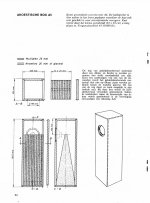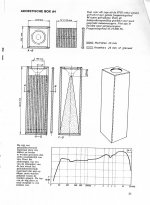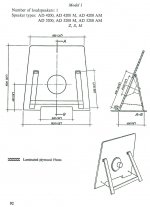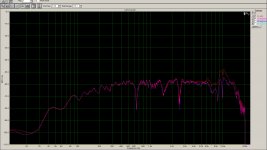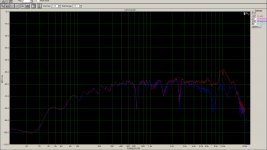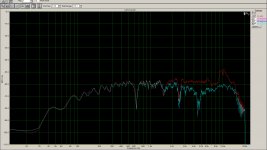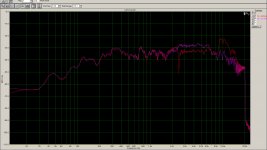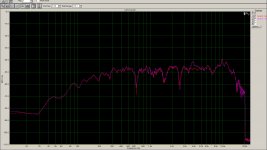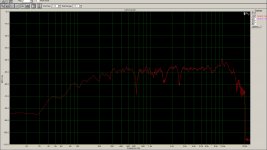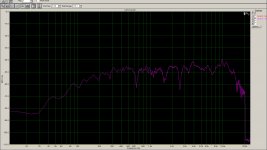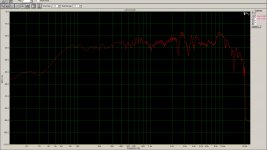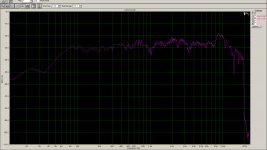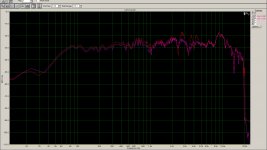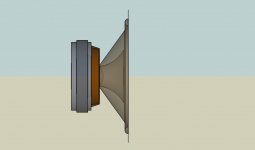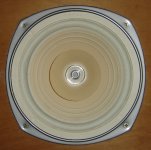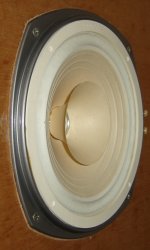I wouldn't like to speculate on the effects of intelligibility, but whizzer cones have an effect a lot lower than 7Khz, if you compare the response of the speaker with and without the whizzer cone, not just the frequencies where the whizzer is the sole source of sound.
Years ago I tested a Coral Flat 8A (8" driver with 160mm cone and 80mm horn shaped whizzer) with and without whizzer, and found the whizzer cone starts to have a large effect on the on and off axis response as low as 2.5Khz.
Specifically the presence of the whizzer cone reduced the on axis response from 2.5Khz to about 6Khz by nearly 3dB, but increased the (30 degree) off axis response by several dB, in other words the dispersion between 2.5Khz and 6Khz was greatly improved at the expense of some loss of on axis response.
However the on axis response without the whizzer actually had a +3dB shelf from 2.5Khz to 6Khz, which suggests the main cone of the driver was deliberately designed with an increased output in this range (probably due to decoupling rings) so that the response was balanced once the whizzer was in place.
Above 7Khz the response of the single main cone by itself disappeared rapidly, so above 7Khz the output is almost entirely the whizzer cone.
So technically the whizzer is only acting as a second separate cone above 7Khz, but between 2.5Khz and 7Khz it is still acting as a source of sound as well as a directivity modifier for the main cone, much like a phase plug would.
The improvement in dispersion is so great that at 4Khz without whizzer cone the 30 degree off axis response was 9dB down on the on axis response (severe beaming) while with the whizzer cone in place the 30 degree off axis response at 4Khz was only 1.8dB down from the on axis response...
Years ago I tested a Coral Flat 8A (8" driver with 160mm cone and 80mm horn shaped whizzer) with and without whizzer, and found the whizzer cone starts to have a large effect on the on and off axis response as low as 2.5Khz.
Specifically the presence of the whizzer cone reduced the on axis response from 2.5Khz to about 6Khz by nearly 3dB, but increased the (30 degree) off axis response by several dB, in other words the dispersion between 2.5Khz and 6Khz was greatly improved at the expense of some loss of on axis response.
However the on axis response without the whizzer actually had a +3dB shelf from 2.5Khz to 6Khz, which suggests the main cone of the driver was deliberately designed with an increased output in this range (probably due to decoupling rings) so that the response was balanced once the whizzer was in place.
Above 7Khz the response of the single main cone by itself disappeared rapidly, so above 7Khz the output is almost entirely the whizzer cone.
So technically the whizzer is only acting as a second separate cone above 7Khz, but between 2.5Khz and 7Khz it is still acting as a source of sound as well as a directivity modifier for the main cone, much like a phase plug would.
The improvement in dispersion is so great that at 4Khz without whizzer cone the 30 degree off axis response was 9dB down on the on axis response (severe beaming) while with the whizzer cone in place the 30 degree off axis response at 4Khz was only 1.8dB down from the on axis response...
Last edited:
I did an experiment with the Lowther DX55 several years ago. I progressively cut the whizzer down until it was no more. (Note that the DX55 whizzer is connected to the main cone and not the pole piece as in other designs.) Regarding "intelligibility", with the whizzer cut off, the music sounded less focused and dull but much easier to listen to for long periods of time. Where the whizzer comes in varies from design and size, but with the DX55 I reckon it was about 3-4kHz. So, hard to generalize about whizzers.
Having said the above and based on what I've heard I prefer whizzerless. However, my favorites are DX55 and Feastrex. But both are exceptions and are costly, and for under $300 or so I would definitely go with 3" whizzerless for offering single driver coherency.
Having said the above and based on what I've heard I prefer whizzerless. However, my favorites are DX55 and Feastrex. But both are exceptions and are costly, and for under $300 or so I would definitely go with 3" whizzerless for offering single driver coherency.
here's the response, on, 30 degrees off and behind outdoors of a doped de-whizzered Fostex 164
An externally hosted image should be here but it was not working when we last tested it.
I wouldn't like to speculate on the effects of intelligibility, but whizzer cones have an effect a lot lower than 7Khz, if you compare the response of the speaker with and without the whizzer cone, not just the frequencies where the whizzer is the sole source of sound.
Years ago I tested a Coral Flat 8A (8" driver with 160mm cone and 80mm horn shaped whizzer) with and without whizzer, and found the whizzer cone starts to have a large effect on the on and off axis response as low as 2.5Khz.
Specifically the presence of the whizzer cone reduced the on axis response from 2.5Khz to about 6Khz by nearly 3dB, but increased the (30 degree) off axis response by several dB, in other words the dispersion between 2.5Khz and 6Khz was greatly improved at the expense of some loss of on axis response.
However the on axis response without the whizzer actually had a +3dB shelf from 2.5Khz to 6Khz, which suggests the main cone of the driver was deliberately designed with an increased output in this range (probably due to decoupling rings) so that the response was balanced once the whizzer was in place.
Above 7Khz the response of the single main cone by itself disappeared rapidly, so above 7Khz the output is almost entirely the whizzer cone.
So technically the whizzer is only acting as a second separate cone above 7Khz, but between 2.5Khz and 7Khz it is still acting as a source of sound as well as a directivity modifier for the main cone, much like a phase plug would.
The improvement in dispersion is so great that at 4Khz without whizzer cone the 30 degree off axis response was 9dB down on the on axis response (severe beaming) while with the whizzer cone in place the 30 degree off axis response at 4Khz was only 1.8dB down from the on axis response...
Great information thanks for sharing. I am not sure if I should be contributing but anyway. To me it seems a whizzer is a engineering compromise for increased bandwidth and dispersion from a singer driver. That comes at the price of phase and weird resonant anomaly's. From my experience of listening to vintage drivers with and without. I never actually find satisfaction with whizzers. But I keep buying vintage drivers with whizzers. I try to keep a open mind.
I do wonder if they don't so much engineer a hump in the response to compensate for the addition of the whizzer. More likely like all drivers have a peak in the midrange where the driver efficiency peaks. And the whizzer is a solution to this. Dual field coils might be another solution. Or inductive circuits that have recently been used.
All so possible most full range drivers originally where never really designed for on axis listening where the phase inversion issues might be most annoying. A lot of whizzer coned full-rangers where designed for off axis listening. Whether they be for floor mounted radios or hifi speakers or pa speakers. I think I enjoy whizzers the most in this application. Less critical listening.
I read about the much loved Phillips 9710m driver. Has a huge mid range peak but possibly mounted on a reflex box mounted low to the floor the response in room maybe quiet even. I am not sure if they where ever intended for back loaded horns but I will attach some rare and old Phillips enclosure designs that we all might find interesting. Well the first two are. Not sure about the third. I hope this isn't too of topic but they are rare and hard to find or they where for me. I thought it would good to put them out more.
Latterly I am trying 5 to 6 inch drivers without whizzers after reading advice for another member. That a more even response can be expected.
Attachments
more on topic
http://www.diyaudio.com/forums/full-range/110257-whizzer-distortion.html
This is a similar thread with info. Interesting it mentions the reasons for the foam on my axiom 301,s Interestingly. My 301 have amazing treble I think. Admittedly I have ruined them with dammer. If I had it over I would never modify such a classic driver in this way whether it improved them or not. There peaky on axis in the upper mid making them flawed but the treble is so pure. I have to try them OB it might change there character totally.
This subject is on my mind presently. As I am having trouble understanding what people say on my bedroom home theater set up. So I pushing forward with new horn speakers trying to obtain better speech intelligibility. My hearing is not so good and digital satellite TV is not so good either.
http://www.diyaudio.com/forums/full-range/110257-whizzer-distortion.html
This is a similar thread with info. Interesting it mentions the reasons for the foam on my axiom 301,s Interestingly. My 301 have amazing treble I think. Admittedly I have ruined them with dammer. If I had it over I would never modify such a classic driver in this way whether it improved them or not. There peaky on axis in the upper mid making them flawed but the treble is so pure. I have to try them OB it might change there character totally.
This subject is on my mind presently. As I am having trouble understanding what people say on my bedroom home theater set up. So I pushing forward with new horn speakers trying to obtain better speech intelligibility. My hearing is not so good and digital satellite TV is not so good either.
Last edited:
yes, thanks for the heads up.
Reminds me on the jordans (or the audience a3's) with a slight climbing response. Ted recommended sitting off axis.
I've wanted to try my a10, off axis it was commented as good from a German review. It has a scary climb of 10db from 1-2khz then stays there (similar to the 206e).
I forgot about whizzers helping dipersion. Most 8" lose directivity above 2khz.
I've been closely looking at the w8-1808 driver...........
Norman
Reminds me on the jordans (or the audience a3's) with a slight climbing response. Ted recommended sitting off axis.
I've wanted to try my a10, off axis it was commented as good from a German review. It has a scary climb of 10db from 1-2khz then stays there (similar to the 206e).
I forgot about whizzers helping dipersion. Most 8" lose directivity above 2khz.
I've been closely looking at the w8-1808 driver...........
Norman
Last edited:
Great information thanks for sharing. I am not sure if I should be contributing but anyway. To me it seems a whizzer is a engineering compromise for increased bandwidth and dispersion from a singer driver. That comes at the price of phase and weird resonant anomaly's. From my experience of listening to vintage drivers with and without. I never actually find satisfaction with whizzers. But I keep buying vintage drivers with whizzers. I try to keep a open mind.
I do wonder if they don't so much engineer a hump in the response to compensate for the addition of the whizzer. More likely like all drivers have a peak in the midrange where the driver efficiency peaks. And the whizzer is a solution to this. Dual field coils might be another solution. Or inductive circuits that have recently been used.
All so possible most full range drivers originally where never really designed for on axis listening where the phase inversion issues might be most annoying. A lot of whizzer coned full-rangers where designed for off axis listening. Whether they be for floor mounted radios or hifi speakers or pa speakers. I think I enjoy whizzers the most in this application. Less critical listening.
I read about the much loved Phillips 9710m driver. Has a huge mid range peak but possibly mounted on a reflex box mounted low to the floor the response in room maybe quiet even. I am not sure if they where ever intended for back loaded horns but I will attach some rare and old Phillips enclosure designs that we all might find interesting. Well the first two are. Not sure about the third. I hope this isn't too of topic but they are rare and hard to find or they where for me. I thought it would good to put them out more.
Latterly I am trying 5 to 6 inch drivers without whizzers after reading advice for another member. That a more even response can be expected.
Thanks for the plans!
Troels Gravesen analysed the 9710 in depth on his website, including a whizzer-ectomy.
Philips 9710/
Scroll down to near the bottom for the comparative FR plot.
IG
Here are some measurements I took of a modified Coral Flat 8A about 8 years ago. From memory taken at about 1 metre with the speaker and mic about 0.7m off the floor.I forgot about whizzers helping dipersion. Most 8" lose directivity above 2khz.
I've been closely looking at the w8-1808 driver...........
Norman
They are slow sine swept narrow band "warts and all" measurements with no 1/3 octave smoothing, windowing or other niceties, and taken indoors mounted non-flush on a fairly crude baffle, so there are both baffle diffraction effects and floor bounce effects in the measurement.
In particular the notches at 650Hz and 1500Hz are floor bounce cancellation and should be ignored, however the notch at about 2.6Khz is an actual notch in driver response due to an "ill advised" un-removable modification, which is another story...

Red is on axis, purple 15 degrees off axis, blue 30 degrees, cyan 45 degrees.
What I find interesting is that despite being an 8" driver the 30 degree off axis response is good to at least 4Khz - about twice what you'd expect from a single 8" cone, so the whizzer really is making a difference. At 45 degrees there is a large drop off.
I did similar measurements on a de-whizzered version of the driver as I mentioned in my previous post, unfortunately I either didn't save them or I've lost them
On axis response from 3Khz to 8Khz (the usual problem range for whizzer cone drivers of this size) is remarkably flat. The peaks around 10-12Khz are resonances of the aluminium dome dust cap, and go away if that is removed.
The notch at 2.6Khz is due the relative phase shift between the two cones, and in their original state the drivers only had a small benign dip in this region, however after coating the whizzer cone with a rubber and carbon compound the notch formed.
 It is audible, and adds a slight nasally sound.
It is audible, and adds a slight nasally sound. Moral of the story, DON'T coat the whizzer cone with anything...at least on Coral drivers...on the other hand, applying a similar coating to both sides of the main cone considerably improved the flatness of the response from 3-8Khz over the original, which was somewhat peaky.
I also experimented with small foam adhesive strips stuck to the rear of the main cone near the perimeter, and this made a big improvement both to these drivers and a pair of Flat 8 Mk 2. Unlike coating mods the foam strips are easily removable, if you don't leave them on for months.... after that they do tend to bond fairly securely - 8 years later they are well and truly stuck and could only be removed by slicing them off.
I'll post more graphs in following posts...
Attachments
Last edited:
great article, thanks.
not what I expected, but makes sense.
I think the flat 8" has better dispersion than the deeper funnel cones nowadays.
My friend at work wants to play with the grs repalcement for the b20, but ghost in a tweet 6db above 5khz on a diy phase plug.
Godzilla didn't like it (grs), too scratchy (mixture of goo to paper off).
Too bad, if you advertise it as a replacement, I'd expect same cone / magnet / surround.
That whizzer vibrating can really fight with the cone causing + and minus frequencies.
I've always liked a bit of poly fill down where whizzer attachs to the cone on b20.
Norman
not what I expected, but makes sense.
I think the flat 8" has better dispersion than the deeper funnel cones nowadays.
My friend at work wants to play with the grs repalcement for the b20, but ghost in a tweet 6db above 5khz on a diy phase plug.
Godzilla didn't like it (grs), too scratchy (mixture of goo to paper off).
Too bad, if you advertise it as a replacement, I'd expect same cone / magnet / surround.
That whizzer vibrating can really fight with the cone causing + and minus frequencies.
I've always liked a bit of poly fill down where whizzer attachs to the cone on b20.
Norman
Last edited:
I tell a lie - I've found the on axis graphs of before and after whizzer removal 
Red is with whizzer, purple without. Without whizzer the sudden rise at about 2.5Khz is obvious, which is maintained as a shelf to about 6Khz before it rolls off. Even without the whizzer there is some treble due to the aluminium dome, although it's many dB down.
The sudden rise in response at 2.5Khz would cause a rapid phase shift as well, and together with any phase shift of the whizzer cone at that frequency is responsible for the notch. Obviously in modifying the damping of the whizzer cone I altered it's phase shift enough to bring the two to 180 degrees out of phase at a single frequency...
Red is with whizzer, purple without. Without whizzer the sudden rise at about 2.5Khz is obvious, which is maintained as a shelf to about 6Khz before it rolls off. Even without the whizzer there is some treble due to the aluminium dome, although it's many dB down.
The sudden rise in response at 2.5Khz would cause a rapid phase shift as well, and together with any phase shift of the whizzer cone at that frequency is responsible for the notch. Obviously in modifying the damping of the whizzer cone I altered it's phase shift enough to bring the two to 180 degrees out of phase at a single frequency...
Attachments
Here are the same Flat 8A drivers after the "cone coating misadventure" but before and after experimenting with foam damping strips on the rear perimeter of the main cone.
I spent a lot of time (weeks) trying different numbers, lengths, and combinations of positioning of strips, both measuring and listening, and the final result was achieved with 8 strips, each 3mm thick, 9mm wide (standard adhesive foam door caulking strip) and 20mm long each. They were placed equally spaced around the perimeter, about 3mm away from the edge of the cone where the surround joins, to give clearance from the rearward facing surround as the cone moves.
Purple is the original response, notice the peak around 4Khz in particular which adds a "zingy" sound that many full range drivers have. Red is after adding the strips, and it's now almost ruler flat through that region, and the zingyness attributable to 4Khz is gone. (There is still a slightly nasal effect due to the 2.6Khz notch)
The third graph shows the two overlaid so you can see how only the problem area is altered with almost laser like precision - only between 3Khz and 8Khz is there any effect, all of it beneficial. Outside that there is a slight <1dB loss in overall sensitivity due to increased cone weight, and slight increase in Qms.
If I knew then what I know now, I would have never made ANY coating modifications to either cone, and gone directly to the foam strips, and I would have had a smooth response from 3-8Khz, and no notch at 2.5Khz.
Although it's safe to apply a moderate damping coating to the main cone (NOT the whizzer cone) just as much improvement if not more can be achieved with the foam strips (at least on these specific drivers) - which can be removed if unsatisfactory, or altered to get just the right balance.
I spent a lot of time (weeks) trying different numbers, lengths, and combinations of positioning of strips, both measuring and listening, and the final result was achieved with 8 strips, each 3mm thick, 9mm wide (standard adhesive foam door caulking strip) and 20mm long each. They were placed equally spaced around the perimeter, about 3mm away from the edge of the cone where the surround joins, to give clearance from the rearward facing surround as the cone moves.
Purple is the original response, notice the peak around 4Khz in particular which adds a "zingy" sound that many full range drivers have. Red is after adding the strips, and it's now almost ruler flat through that region, and the zingyness attributable to 4Khz is gone. (There is still a slightly nasal effect due to the 2.6Khz notch)
The third graph shows the two overlaid so you can see how only the problem area is altered with almost laser like precision - only between 3Khz and 8Khz is there any effect, all of it beneficial. Outside that there is a slight <1dB loss in overall sensitivity due to increased cone weight, and slight increase in Qms.
If I knew then what I know now, I would have never made ANY coating modifications to either cone, and gone directly to the foam strips, and I would have had a smooth response from 3-8Khz, and no notch at 2.5Khz.
Although it's safe to apply a moderate damping coating to the main cone (NOT the whizzer cone) just as much improvement if not more can be achieved with the foam strips (at least on these specific drivers) - which can be removed if unsatisfactory, or altered to get just the right balance.
Attachments
Finally the same damping strip modifications on some different drivers - a pair of Coral Flat 8 Mark II, superficially a similar driver with the same cone design, but the measured response is very different.
(Again, these measurements are narrow band slow swept sine, no windowing or 1/3rd octave averaging, and were taken indoors on a rough baffle at about 1 metre)
Red is the "as is" no modification response. Pretty ragged looking between 2Khz and 5Khz, and with a noticeable edginess to the upper midrange on an otherwise outstanding overall sound. (Nowhere near as edgy sounding as a Fostex FE207E I had on hand to compare it with, despite the scary looking measurement)
Clearly something was not right there. There are many differences between the two drivers - the Flat 8A were original factory assembled units that had spent ~30 years sitting in cabinets in use before I got my hands on them.
The cones had softened noticeably with age and moisture exposure, (New Zealand is very humid at certain times of year) which for the main cone is a good thing IMHO, whilst a bad thing for the whizzer cone. It also had my coating on the cones, which again was beneficial for the main cone but detrimental to the whizzer cone. The suspension of the Flat 8A's are also very stiff and highly damped, and probably provide good termination for the standing waves.
On the other hand the pair of Flat 8 Mark II I got were "hand assembled from spare parts" units that had been put together from sealed replacement cones/frames/magnets etc. So although they're an old design they were essentially as-new when I got them in 2003. The cones were very dry and new and the surround was very soft and supple compared to the Flat 8A - which improves the bass response immensely but I suspect is detrimental to the edge damping at upper midrange frequencies where the main cone is breaking up.
Mic measurement around the perimeter of the main cone showed serious breakup in the 2-5Khz range that wasn't present on the modified Flat 8A's and after being burnt already by making ill advised permanent cone modifications to the previous drivers, I decided to avoid any type of coating or permanent modification and go straight to the foam damping strips.
Although I ended up using the same number of strips equally spaced around the cone, I found I got the best results with these drivers if I staggered their distance from the centre of the cone by about 5mm for each alternate strip. The end result I got is shown in purple.
Still not as flat as as the Flat 8A from 3Khz - 8Khz, but a huge improvement. On the plus side there is no deep notch at 2.6Khz, which I believe is due to the whizzer cone being dry and crisp with no modifications, although the whizzer cone on the Flat 8 Mark II also protrudes 5mm further forward than the Flat 8A, which may also play a role in the response at 2.6Khz due to a small difference in acoustic phase shift.
Compared to the unmodified response the notches at 2.5 and 3.5Khz are considerably lessened, the peak at 2.8Khz brought into line, and the peaks and notches between 3.5Khz and 5Khz completely eliminated.
Overall there is a 1dB loss in sensitivity from 95dB to 94dB/W/M due to increased cone mass.
The most important thing is how does it sound ? Basically all traces of edginess or zingyness in the midrange are gone, and other than a small amount of sibilance in the treble around 10-12Khz due to the aluminium dome resonance, I really can't fault the sound.
For a dual cone driver it sounds exceptionally clean, cleaner than a lot of conventional drivers, and there is almost no hint of the random "cone breakup" sound in the upper midrange that so many drivers have, which was noticeable before modding.
I feel that if I was to coat the main cone with a thin damping coating (not damar though) that there would be further improvements in the 3-8Khz range that I saw on the other drivers, however I'm not willing to take the risk. Interestingly, in the 7 years since the mods that the driver has been in use the response in this range has further flattened and improved - these graphs were all taken in 2003 and when I recently measured them they were flatter across 3-8Khz, which I believe is due to a slight softening of the main cones with age and moisture exposure leading to slightly higher losses in the main cone for standing waves.
I could also get rid of the resonance at ~10Khz if I eliminated the aluminium dust cap and maybe went for a phase plug, but again I'm not willing to make such one way modifications on my only pair when they sound more than good enough as is.
As an interesting aside, I also have a pair of Fostex FE207E, and I've never been happy with their response in the 2-6Khz range, not only do they have a huge peak at 2.5Khz (with associated zingyness) they have a very obvious "random cone breakup" sound in that region as well, which sounds awful on any massed instruments like strings.
I've attempted the foam strip modification on the Fostex drivers and although it made a very small change to the measured frequency response it was essentially a complete failure, as it didn't provide any worthwhile improvement in sound - it just changed the nature of the flaw slightly.
It's not entirely clear to me why the mod doesn't work on them, although I suspect it's related to the lack of decoupling rings on the Fostex driver, and the main cone properties in general.
They also don't have nearly as good treble or high frequency dispersion, in short the modified Flat 8 Mark II completely walks all over the FE207E in every way, better bass, cleaner midrange, better treble and high frequency dispersion...The Coral's have been in daily use for 8 years while the Fostex drivers sit in their original shipping boxes...
Anyway, I hope this is useful or interesting to those interested in tweaking full range drivers
(Again, these measurements are narrow band slow swept sine, no windowing or 1/3rd octave averaging, and were taken indoors on a rough baffle at about 1 metre)
Red is the "as is" no modification response. Pretty ragged looking between 2Khz and 5Khz, and with a noticeable edginess to the upper midrange on an otherwise outstanding overall sound. (Nowhere near as edgy sounding as a Fostex FE207E I had on hand to compare it with, despite the scary looking measurement)
Clearly something was not right there. There are many differences between the two drivers - the Flat 8A were original factory assembled units that had spent ~30 years sitting in cabinets in use before I got my hands on them.
The cones had softened noticeably with age and moisture exposure, (New Zealand is very humid at certain times of year) which for the main cone is a good thing IMHO, whilst a bad thing for the whizzer cone. It also had my coating on the cones, which again was beneficial for the main cone but detrimental to the whizzer cone. The suspension of the Flat 8A's are also very stiff and highly damped, and probably provide good termination for the standing waves.
On the other hand the pair of Flat 8 Mark II I got were "hand assembled from spare parts" units that had been put together from sealed replacement cones/frames/magnets etc. So although they're an old design they were essentially as-new when I got them in 2003. The cones were very dry and new and the surround was very soft and supple compared to the Flat 8A - which improves the bass response immensely but I suspect is detrimental to the edge damping at upper midrange frequencies where the main cone is breaking up.
Mic measurement around the perimeter of the main cone showed serious breakup in the 2-5Khz range that wasn't present on the modified Flat 8A's and after being burnt already by making ill advised permanent cone modifications to the previous drivers, I decided to avoid any type of coating or permanent modification and go straight to the foam damping strips.
Although I ended up using the same number of strips equally spaced around the cone, I found I got the best results with these drivers if I staggered their distance from the centre of the cone by about 5mm for each alternate strip. The end result I got is shown in purple.
Still not as flat as as the Flat 8A from 3Khz - 8Khz, but a huge improvement. On the plus side there is no deep notch at 2.6Khz, which I believe is due to the whizzer cone being dry and crisp with no modifications, although the whizzer cone on the Flat 8 Mark II also protrudes 5mm further forward than the Flat 8A, which may also play a role in the response at 2.6Khz due to a small difference in acoustic phase shift.
Compared to the unmodified response the notches at 2.5 and 3.5Khz are considerably lessened, the peak at 2.8Khz brought into line, and the peaks and notches between 3.5Khz and 5Khz completely eliminated.
Overall there is a 1dB loss in sensitivity from 95dB to 94dB/W/M due to increased cone mass.
The most important thing is how does it sound ? Basically all traces of edginess or zingyness in the midrange are gone, and other than a small amount of sibilance in the treble around 10-12Khz due to the aluminium dome resonance, I really can't fault the sound.
For a dual cone driver it sounds exceptionally clean, cleaner than a lot of conventional drivers, and there is almost no hint of the random "cone breakup" sound in the upper midrange that so many drivers have, which was noticeable before modding.
I feel that if I was to coat the main cone with a thin damping coating (not damar though) that there would be further improvements in the 3-8Khz range that I saw on the other drivers, however I'm not willing to take the risk. Interestingly, in the 7 years since the mods that the driver has been in use the response in this range has further flattened and improved - these graphs were all taken in 2003 and when I recently measured them they were flatter across 3-8Khz, which I believe is due to a slight softening of the main cones with age and moisture exposure leading to slightly higher losses in the main cone for standing waves.
I could also get rid of the resonance at ~10Khz if I eliminated the aluminium dust cap and maybe went for a phase plug, but again I'm not willing to make such one way modifications on my only pair when they sound more than good enough as is.
As an interesting aside, I also have a pair of Fostex FE207E, and I've never been happy with their response in the 2-6Khz range, not only do they have a huge peak at 2.5Khz (with associated zingyness) they have a very obvious "random cone breakup" sound in that region as well, which sounds awful on any massed instruments like strings.
I've attempted the foam strip modification on the Fostex drivers and although it made a very small change to the measured frequency response it was essentially a complete failure, as it didn't provide any worthwhile improvement in sound - it just changed the nature of the flaw slightly.
It's not entirely clear to me why the mod doesn't work on them, although I suspect it's related to the lack of decoupling rings on the Fostex driver, and the main cone properties in general.
They also don't have nearly as good treble or high frequency dispersion, in short the modified Flat 8 Mark II completely walks all over the FE207E in every way, better bass, cleaner midrange, better treble and high frequency dispersion...The Coral's have been in daily use for 8 years while the Fostex drivers sit in their original shipping boxes...
Anyway, I hope this is useful or interesting to those interested in tweaking full range drivers
Attachments
Last edited:
Thanks for the plans!
Troels Gravesen analysed the 9710 in depth on his website, including a whizzer-ectomy.
Philips 9710/
Scroll down to near the bottom for the comparative FR plot.
IG
Yes I have read this. It saved me from doing the same and finding out the hard away and certainly is evidence of the effect of the whizzer flattening out the response peak. He all so mentions the depth of the cones causing real phase issues. I note some of the best klangfilm drivers have a very flat profile and of course the 755a is another eg of flat cone sound quality. The coral flat series being another. I guess its always going to be a compromise between deeper dish for increased strength verses shallower possible weaker but better phase relationships. I am sure there is a whole lot of other factors I don't understand.
And yet on this site elsewhere there is a Asian diyer that is making cones that are practically 90 degree cones claiming there the holy grail of audio. So god knows what is right. His cones are supa fragile rice paper and neo magnets.
I think when it get's down to it and getting back to topic. Ultimate intelligibility is going to come on axis from a whizzerless possibly flat cone. My purest full range to date are grundig 8 inchers on open baffle with out whizzers and with phenolic spiders and huge alnico magnets. They do peak in the middle though . And I am confident I could do better going down to 5 and 6 inch drivers.
One final though. Real efficiency is a factor to intelligibility anything below 96db and your losing speech intelligibility. Real speech has huge dynamic peaks and they have to remain. Anyone else agree with that? Thats one of the reason I am stepping up to horns. And probably why most public address systems involve horns or used too.
Finally the same damping strip modifications on some different drivers - a pair of Coral Flat 8 Mark II, superficially a similar driver with the same cone design, but the measured response is very different.
(Again, these measurements are narrow band slow swept sine, no windowing or 1/3rd octave averaging, and were taken indoors on a rough baffle at about 1 metre)
Red is the "as is" no modification response. Pretty ragged looking between 2Khz and 5Khz, and with a noticeable edginess to the upper midrange on an otherwise outstanding overall sound. (Nowhere near as edgy sounding as a Fostex FE207E I had on hand to compare it with, despite the scary looking measurement)
Clearly something was not right there. There are many differences between the two drivers - the Flat 8A were original factory assembled units that had spent ~30 years sitting in cabinets in use before I got my hands on them.
The cones had softened noticeably with age and moisture exposure, (New Zealand is very humid at certain times of year) which for the main cone is a good thing IMHO, whilst a bad thing for the whizzer cone. It also had my coating on the cones, which again was beneficial for the main cone but detrimental to the whizzer cone. The suspension of the Flat 8A's are also very stiff and highly damped, and probably provide good termination for the standing waves.
On the other hand the pair of Flat 8 Mark II I got were "hand assembled from spare parts" units that had been put together from sealed replacement cones/frames/magnets etc. So although they're an old design they were essentially as-new when I got them in 2003. The cones were very dry and new and the surround was very soft and supple compared to the Flat 8A - which improves the bass response immensely but I suspect is detrimental to the edge damping at upper midrange frequencies where the main cone is breaking up.
Mic measurement around the perimeter of the main cone showed serious breakup in the 2-5Khz range that wasn't present on the modified Flat 8A's and after being burnt already by making ill advised permanent cone modifications to the previous drivers, I decided to avoid any type of coating or permanent modification and go straight to the foam damping strips.
Although I ended up using the same number of strips equally spaced around the cone, I found I got the best results with these drivers if I staggered their distance from the centre of the cone by about 5mm for each alternate strip. The end result I got is shown in purple.
Still not as flat as as the Flat 8A from 3Khz - 8Khz, but a huge improvement. On the plus side there is no deep notch at 2.6Khz, which I believe is due to the whizzer cone being dry and crisp with no modifications, although the whizzer cone on the Flat 8 Mark II also protrudes 5mm further forward than the Flat 8A, which may also play a role in the response at 2.6Khz due to a small difference in acoustic phase shift.
Compared to the unmodified response the notches at 2.5 and 3.5Khz are considerably lessened, the peak at 2.8Khz brought into line, and the peaks and notches between 3.5Khz and 5Khz completely eliminated.
Overall there is a 1dB loss in sensitivity from 95dB to 94dB/W/M due to increased cone mass.
The most important thing is how does it sound ? Basically all traces of edginess or zingyness in the midrange are gone, and other than a small amount of sibilance in the treble around 10-12Khz due to the aluminium dome resonance, I really can't fault the sound.
For a dual cone driver it sounds exceptionally clean, cleaner than a lot of conventional drivers, and there is almost no hint of the random "cone breakup" sound in the upper midrange that so many drivers have, which was noticeable before modding.
I feel that if I was to coat the main cone with a thin damping coating (not damar though) that there would be further improvements in the 3-8Khz range that I saw on the other drivers, however I'm not willing to take the risk. Interestingly, in the 7 years since the mods that the driver has been in use the response in this range has further flattened and improved - these graphs were all taken in 2003 and when I recently measured them they were flatter across 3-8Khz, which I believe is due to a slight softening of the main cones with age and moisture exposure leading to slightly higher losses in the main cone for standing waves.
I could also get rid of the resonance at ~10Khz if I eliminated the aluminium dust cap and maybe went for a phase plug, but again I'm not willing to make such one way modifications on my only pair when they sound more than good enough as is.
As an interesting aside, I also have a pair of Fostex FE207E, and I've never been happy with their response in the 2-6Khz range, not only do they have a huge peak at 2.5Khz (with associated zingyness) they have a very obvious "random cone breakup" sound in that region as well, which sounds awful on any massed instruments like strings.
I've attempted the foam strip modification on the Fostex drivers and although it made a very small change to the measured frequency response it was essentially a complete failure, as it didn't provide any worthwhile improvement in sound - it just changed the nature of the flaw slightly.
It's not entirely clear to me why the mod doesn't work on them, although I suspect it's related to the lack of decoupling rings on the Fostex driver, and the main cone properties in general.
They also don't have nearly as good treble or high frequency dispersion, in short the modified Flat 8 Mark II completely walks all over the FE207E in every way, better bass, cleaner midrange, better treble and high frequency dispersion...The Coral's have been in daily use for 8 years while the Fostex drivers sit in their original shipping boxes...
Anyway, I hope this is useful or interesting to those interested in tweaking full range drivers
Think I learned from this thread is that I not going to try as probably make them worse. I never new that even a whizzerless cone can have phase reversal. If I understood correctly.
Interestingly but a little off topic lomo kinap drivers have what looks like a enable pattern embossed into the outer rim of some of there bass drivers.
Would you believe I had a set of coral flat 8 and a pair of focal tweeters and some one broke in stole one flat 8 one focal td90 tweeter.
The Coral Flat series are relatively deep cone profile for an 8" driver IMHO, they are considerably deeper than the FE207E, which has a much shallower main cone taper as well as a much smaller, shallow, straight taper whizzer.He all so mentions the depth of the cones causing real phase issues. I note some of the best klangfilm drivers have a very flat profile and of course the 755a is another eg of flat cone sound quality. The coral flat series being another.
I've attached a couple of pics of the Flat 8 Mark 2 as well as a transparent side view (with basket hidden) of a Sketchup model of the drivers that I made some time back that shows the cone profiles well.
An interesting discovery was that when I came to try to model the curve of the whizzer cone accurately in 3D, I discovered that the side profile of the curvature is exactly a circular arc
I'm not sure that a shallow cone necessarily gives the best phase relationships for a driver that is designed to operate several octaves into cone breakup. Basically most large full range drivers that reach up to the treble are acting as bending wave transducers - the impulse travels down the cone from the voice coil to the edge of the cone like a wave from a stone thrown into a pool, and is (hopefully, but usually not) absorbed at the end to avoid standing waves.I guess its always going to be a compromise between deeper dish for increased strength verses shallower possible weaker but better phase relationships. I am sure there is a whole lot of other factors I don't understand.
(Failure to absorb and control these bending waves before they reach the edge are the primary cause of resonances in the cone, and the associated ragged frequency response many full range drivers have)
Sound travels a lot faster in paper than it does in air, but by sloping the cone to the right angle you can launch a coherent wave front at high frequencies even from a large cone. You want the angle such that the directly forward vector of the sound velocity travelling through the cone at is equal to the forward velocity of the wave in the air once it has left the cone - as the wave travels along the cone it keeps in time with the nearby wave that has already left the middle part of the cone and is propagating through the air.
If you fail to do this, peaks and dips in the on axis response will result even if the edge of the cone was perfectly damped. Every different cone material and composition has a different bending wave velocity, so the optimal cone angle will depend on the cone material.
Many full range drivers especially pre-CAD era designs probably got this parameter wrong (among many others) hence a very non flat response, but there were probably a few that got it pretty close to right - whether by luck or lots of trial and error / design iteration.
Attachments
Any driver/cone that has ups and downs in the amplitude response has phase reversals. When the amplitude response is going up with frequency you get phase lead, when it's falling you get phase lag. The steeper the amplitude changes the more the phase shift.Think I learned from this thread is that I not going to try as probably make them worse. I never new that even a whizzerless cone can have phase reversal. If I understood correctly.
Insufficient damping of the main cone, especially near the edge, causes exactly those kind of ups and downs because standing wave patterns form on the cone. The right amount of damping in the right places reduces the reflected waves, therefore decreases the amplitude of the standing waves, and decreases the variations in the frequency and phase response.
With a whizzer cone you have an extra spanner in the works - you now have two separate cones which are physically displaced (introducing acoustic phase shift) and which have their own independent standing wave patterns, and therefore their own independent amplitude and phase variations.
Below the first breakup frequency (approximately 2Khz on the Flat 8) both cones move in unison so the whizzer has no net effect. In the range where both cones are operating, but have different amplitude/phase responses (about 2Khz to 7Khz on the Flat 8) the two cones can add or subtract from each others responses depending on their total relative phase shift.
A notch occurs when there is a total of 180 degree phase shift, (seen from the listener) due to both acoustic phase shift from the physical displacement, and additional phase shift due to phase response anomalies of one or both cones. If their amplitude at that frequency is fairly close the notch can be very deep indeed. (As in the example graphs I gave with the Flat 8A)
The key to avoiding those notches is avoiding 180 degree phase shift between the two cones, but if one or both cones has large amplitude and phase variations caused by standing waves that's a nearly impossible challenge.
I think most people assume the whizzer cone is the culprit in full range drivers, and it may be on many drivers, but at least on the Flat 8, my own measuring and tweaking suggests that Coral got the design of the whizzer cones almost spot on, and that it's the main cone that's the real culprit, through lack of edge damping.
Close mic (less than 1cm) measurements near the edges of the whizzer cone show a comparatively smooth response in the "problem area" of 3-6Khz, whilst a similar close mic measurement of the outer edge of an unmodified main cone show severe cone breakup.
The severe cone breakup results in rapidly and wildly shifting phase (and amplitude) response from the main cone, which would show up as frequency response variations even with the one cone on it's own.
However add the whizzer cone into the mix and the situation now becomes much worse, because now you have two sources of sound - the whizzer cone with a comparatively smooth response, and the main cone with wildly shifting amplitude and phase response, and it's inevitable that at some frequencies the phase shift will reach 180 degrees causing a notch, and 0 degrees causing a peak - having the whizzer cone in place vastly exaggerates the amplitude errors, even if the whizzer cone itself had a perfectly flat response.
So removing the whizzer cone reduces the severity of the problem but it doesn't really solve it because it's not the real culprit. On the other hand, if you can apply just the right damping to the main cone, particularly near the edges to get it's cone breakup under control, minimize standing waves, minimizes amplitude and phase variations of the main cone response, with a bit of luck and careful design you can get the two cones to track closely enough in phase that they never go near the danger zone of 180 degrees - thus you don't get any notches.
The fact that two drivers with essentially the same cone design and geometry can measure so differently (one with a huge notch at 2.5Khz and the other without) shows just how important the damping of the cone is to control the phase relationship, and what an enormous challenge it is to design a good whizzer cone driver.
Argh..... that is a terrible shame indeedWould you believe I had a set of coral flat 8 and a pair of focal tweeters and some one broke in stole one flat 8 one focal td90 tweeter.
I got both my pairs of Flat 8's around 2003/2004 when they were hard but not impossible to come by, and I've been looking for the last 2 years and haven't been able to find another pair anywhere at any price. I really want one more pair for a project, but I've pretty much given up on ever finding any, which is one reason why I'm not willing to do any non undo-able mods to them.
I'm fairly confident in the foam strip mod and would happily perform that to another pair, but I would not be coating the cones with anything, especially the whizzers...
I had a break-in a few years ago too, my speakers weren't touched, but they did make an attempt to steal my DEQ2496, which was on the top of the equipment stack, but were seemingly unable to as they couldn't get the XLR connectors to release
(PS I hadn't read your post where you said you owned a pair of Flat 8's before posting pictures of mine
Last edited:
so..............
Whizzers don't hurt intelligibility ?
To me a crossover high enough doesn't hurt intelligibility either.
I had the b20 crossed to a 1038a piezo at 24db LR at 5khz (active crossover), sounded great then, but I think my ears are more discriminating now.
Norman
Whizzers don't hurt intelligibility ?
To me a crossover high enough doesn't hurt intelligibility either.
I had the b20 crossed to a 1038a piezo at 24db LR at 5khz (active crossover), sounded great then, but I think my ears are more discriminating now.
Norman
I'm not sure intelligibility is the right word to use. In audio that generally means ability to understand speech clearly - which is focused on the range between 300Hz-3000Hz as typically passed by telephone systems, and a deliberate emphasis in the midrange can enhance speech intelligibility, especially relative to low frequencies, but that's not what we want for music.so..............
Whizzers don't hurt intelligibility ?
To me a crossover high enough doesn't hurt intelligibility either.
What I think you really mean is does a whizzer hurt fidelity, to which my response would be, in a lot of designs yes, but not universally IMHO.
The thing to remember is that a whizzer cone essentially makes the driver into a two way design, and just like a conventional two way design a poorly integrated crossover can destroy the result.
By making the design more complicated the designer gives themselves more rope to hang themselves, just like any multi-way design.
The advantage compared to a normal 2 way though is that there is no electrical crossover to deal with - the crossover is purely mechanical, and the cones are concentric, which gets rid of lobing, at least up until mid treble frequencies where the distance between the two cones starts to cause some off axis lobing.
The problem is it just seems to be incredibly hard to get the design right, as the only way you can adjust the acoustic crossover between the cones is to adjust the properties of the cones themselves, and with large cones working at high frequencies even very small changes in cone composition and damping on the order of manufacturing tolerances can cause large changes in the high frequency response. (A very delicate balancing act is going on)
The whizzer cone being further forward than the main cone introduces relative phase shift, but the physical phase shift between the two for a constant distance increases with frequency, so unless the phase response of the two cones in other regards tracks in the right way you can end up with the phase of the two cones rolling around one or more times causing peaks and dips in the summed response. (The exact forward displacement of the whizzer is critical in a given design)
Another problem is that the crossover region tends to be quite wide - a couple of Octaves or so on the Flat 8, from about 2Khz to 8Khz. Getting some sort of phase tracking between the two cones over a large range is again difficult.
I think many full range whizzer cone designs including some current ones focus too much on trying to achieve the best possible high frequency extension at the top end, and don't pay nearly enough attention to the crossover region in the upper midrange...and also don't pay enough attention to damping the outer main cone.
From what I've seen with the tweaking I've done on different drivers, if you can get a smooth well controlled response from the main cone so that you don't get wild phase variations between the two cones, half the battle is won, but none of the designs I've seen seem to pay much attention to it.
The decoupling rings on the Coral drivers are a half hearted attempt in the right direction but they needed to add more damping in the sections of the cone beyond the first decoupling ring, otherwise at high frequencies those decoupled regions flap about uncontrolled.
I've often thought that a good approach might be a 3 layer sandwich cone where the outer 1/3 of the cone radius had a middle layer of very thin (<0.5mm) foam sandwiched between two layers of paper, so that the bending wave losses increased rapidly beyond a certain radius, and were hopefully fully absorbed by the time they reached the edge.
I usually run my Flat 8's with a couple of Ribbon tweeters crossed at 4Khz 18db/oct, and it sounds great to me. (Heresy to some perhaps)I had the b20 crossed to a 1038a piezo at 24db LR at 5khz (active crossover), sounded great then, but I think my ears are more discriminating now.
Norman
However it's nice to sometimes listen to them by themselves full range - they need a few dB of boost in the treble, and I recently spent a few hours adjusting an EQ profile to give about the same perceived balance as the ribbon tweeters, and the result is very satisfactory and enjoyable.
The coherence through the crossover region of 4Khz is noticably improved when there is no crossover there, and on some types of music the result is slightly better because of it, however there is a small amount of sibilance around 10Khz and there is no denying that the treble of the ribbon tweeter is vastly smoother, cleaner, and crisper than any amount of EQ of the full range driver, and most recordings sound better with the ribbon tweeter in place IMO, so I tend to listen to them that way. But on their own, full range, with the right EQ curve on many recordings you can almost convince yourself that the tweeters are actually operating
Last edited:
Very informative. Thank you DB Mandrake. So surround types are of great importance if you want to damp resonances and smooth out response? I think if so this is a tweak I could play with. I bought some chamois leather with hope to make some surrounds out of it. BTW Can just making foam rings that overlap the surround and go up the cone a little be helpful in smoothing out resonances?
- Home
- Loudspeakers
- Full Range
- whizzer and intelligibility ?
